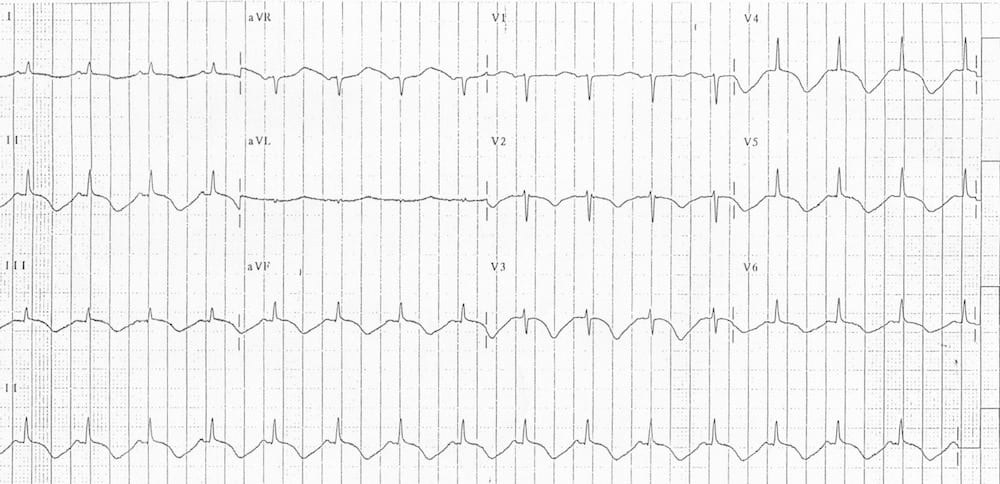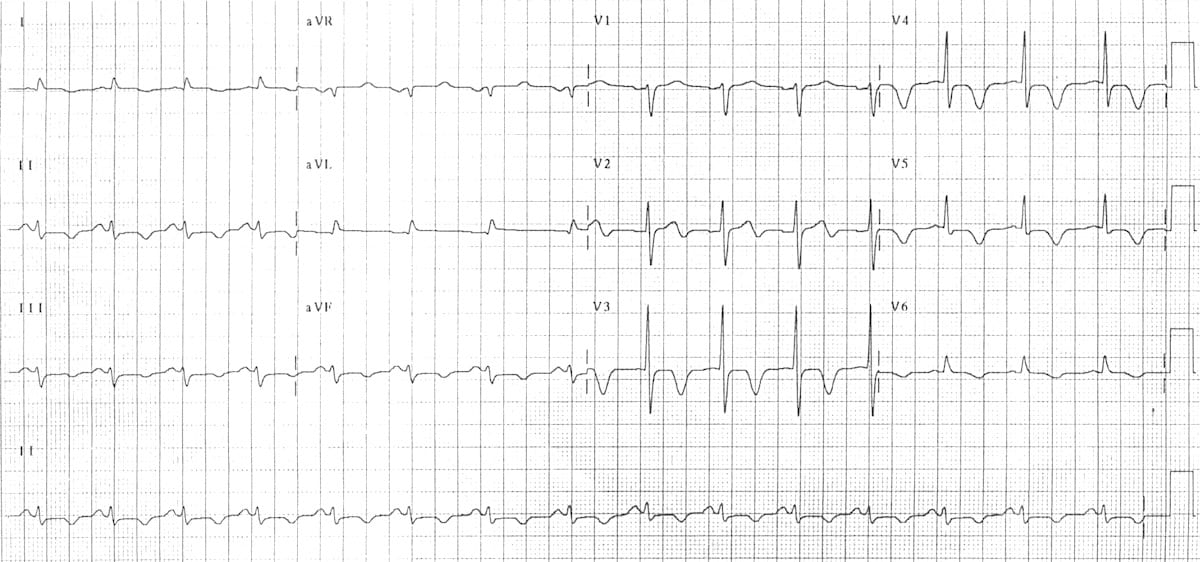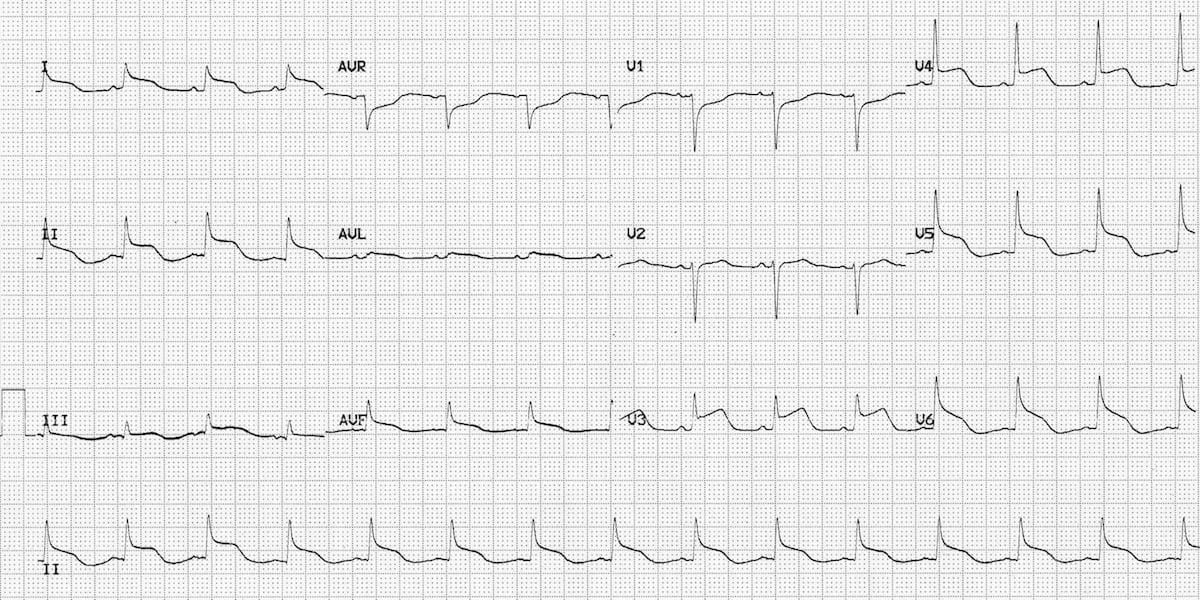Raised Intracranial Pressure
Characteristic ECG Abnormalities with Raised Intracranial Pressure
- Widespread giant T-wave inversions (“cerebral T waves”)
- QT prolongation
- Bradycardia (the Cushing reflex – indicates imminent brainstem herniation)
Other possible ECG changes that may be seen:
- ST segment elevation / depression — this may mimic myocardial ischaemia or pericarditis
- Increased U wave amplitude
- Other rhythm disturbances: sinus tachycardia, junctional rhythms, premature ventricular contractions, atrial fibrillation
In some cases, these ECG abnormalities may be associated with echocardiographic evidence of regional ventricular wall motion abnormality (so-called “neurogenic stunned myocardium”).
Causes
ECG changes due to raised ICP are most commonly seen with massive intracranial haemorrhage:
- Subarachnoid haemorrhage
- Intraparenchymal haemorrhage (haemorrhagic stroke)
They may also be seen with:
- Massive ischaemic stroke causing cerebral oedema (e.g. MCA occlusion)
- Traumatic brain injury
- Cerebral metastases (rarely)
In one case series, the ECG pattern of cerebral T-waves with prolonged QT interval was seen in 72% of patients with SAH and 57% of patients with intraparenchymal haemorrhage.
ECG Examples
Example 1

Subarachnoid Haemorrhage
- Widespread, giant T-wave inversions (“cerebral T waves”) secondary to subarachnoid haemorrhage
- The QT interval is also grossly prolonged (600 ms)
Example 2

Subarachnoid Haemorrhage
- Another example of cerebral T-waves with marked QT prolongation secondary to subarachnoid haemorrhage
Example 3

Subarachnoid Haemorrhage
- Widespread T-wave inversions with slight ST depression secondary to subarachnoid haemorrhage
- The QT interval is prolonged (greater than half the R-R interval)
- This ECG pattern could easily be mistaken for myocardial ischaemia as the T-wave morphology is very similar, although obviously the clinical picture would be very different (coma versus chest pain)
Example 4

Traumatic Brain Injury
- This ECG was taken from a previously healthy 18-year old girl with severe traumatic brain injury and massively raised intracranial pressure (30-40 mmHg)
- There is widespread ST elevation with a pericarditis-like morphology and no reciprocal change (except in aVR and V1)
- She had no cardiac injury / abnormality to explain the ST elevation
- The ST segments normalised as the intracranial pressure came under control (following treatment with thiopentone and hypertonic saline)
Related Topics
- CCC — Subarachnoid Haemorrhage: Overview
- CCC — Subarachnoid Haemorrhage: ICU Management
- CCC — Monitoring in Subarachnoid Haemorrhage
- CCC — Subarachnoid Haemorrhage Grading Systems
- CCC — Vasospasm in Subarachnoid Haemorrhage
- CCC — Subarachnoid Haemorrhage: Initial Management
- CCC — Subarachnoid Haemorrhage: Prognostication
- CCC — Subarachnoid Haemorrhage: Complications
References
- Jachuck, SJ. Electrocardiographic abnormalities associated with raised intracranial pressure. Br Med J. 1975 Feb 1; 1(5952): 242–244. PMC 1672050
- Gregory, T. Cardiovascular complications of brain injury. Contin Educ Anaesth Crit Care Pain (2012) 12 (2): 67-71. doi: 10.1093/bjaceaccp/mkr058
Advanced Reading
Online
- Wiesbauer F, Kühn P. ECG Mastery: Yellow Belt online course. Understand ECG basics. Medmastery
- Wiesbauer F, Kühn P. ECG Mastery: Blue Belt online course: Become an ECG expert. Medmastery
- Kühn P, Houghton A. ECG Mastery: Black Belt Workshop. Advanced ECG interpretation. Medmastery
- Rawshani A. Clinical ECG Interpretation ECG Waves
- Smith SW. Dr Smith’s ECG blog.
- Wiesbauer F. Little Black Book of ECG Secrets. Medmastery PDF
Textbooks
- Zimmerman FH. ECG Core Curriculum. 2023
- Mattu A, Berberian J, Brady WJ. Emergency ECGs: Case-Based Review and Interpretations, 2022
- Straus DG, Schocken DD. Marriott’s Practical Electrocardiography 13e, 2021
- Brady WJ, Lipinski MJ et al. Electrocardiogram in Clinical Medicine. 1e, 2020
- Mattu A, Tabas JA, Brady WJ. Electrocardiography in Emergency, Acute, and Critical Care. 2e, 2019
- Hampton J, Adlam D. The ECG Made Practical 7e, 2019
- Kühn P, Lang C, Wiesbauer F. ECG Mastery: The Simplest Way to Learn the ECG. 2015
- Grauer K. ECG Pocket Brain (Expanded) 6e, 2014
- Surawicz B, Knilans T. Chou’s Electrocardiography in Clinical Practice: Adult and Pediatric 6e, 2008
- Chan TC. ECG in Emergency Medicine and Acute Care 1e, 2004
LITFL Further Reading
- ECG Library Basics – Waves, Intervals, Segments and Clinical Interpretation
- ECG A to Z by diagnosis – ECG interpretation in clinical context
- ECG Exigency and Cardiovascular Curveball – ECG Clinical Cases
- 100 ECG Quiz – Self-assessment tool for examination practice
- ECG Reference SITES and BOOKS – the best of the rest
ECG LIBRARY
MBBS DDU (Emergency) CCPU. Adult/Paediatric Emergency Medicine Advanced Trainee in Melbourne, Australia. Special interests in diagnostic and procedural ultrasound, medical education, and ECG interpretation. Co-creator of the LITFL ECG Library. Twitter: @rob_buttner

